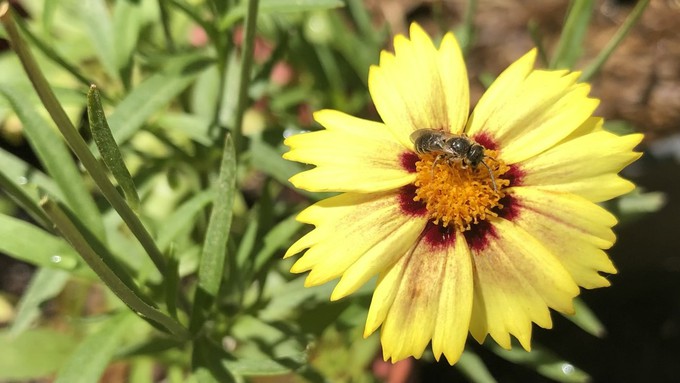
Green Acres presents a free talk on ‘pollinator buffets’ this Saturday

A ligated furrow bee stops in for some pollen on this two-color coreopsis, aka tickweed. Learn about plants that entice pollinators during a free talk 10 a.m. Saturday at all Green Acres sites. Kathy Morrison
From the biggest carpenter bees to tiny sweat bees, from hummingbirds and bats to beetles, moths and butterflies, our natural world depends heavily on the continued efforts of pollinators.
One quick fact here: Approximately 75 percent of flowering plant species need the help of animals to move their heavy pollen grains from plant to plant (or within the plant) for fertilization. This of course include flowers on fruit trees and vegetable plants -- the plants that help feed us.
June is the month to celebrate these hard-working creatures. It's not only Pollinator Month, but next week, June 17-23, is designated Pollinator Week.
Why do pollinators need so much p.r.? They unfortunately continue to be endangered by disappearing natural habitats, urbanization, and the indiscriminate use of pesticides in gardening and farming.
The Pollinator Partnership, based in San Francisco, sponsors Pollinator Week activities. The group encourages plantings to feed pollinators, especially with native and nectar-heavy plants.
In line with that, all Green Acres Nursery and Supply stores in the Sacramento region this Saturday will present on "Grow a Pollinator Buffet." The talk is free and starts at 10 a.m.
I see quite a few pollinators in my home garden now, but it does take some time and thought to develop a welcoming landscape. Here are a few tips beyond planting to attract pollinators and help them thrive:
-- Leave some open ground for native ground-nesting bees, and leave it alone. I turned over some soil in the garden one time and sent one poor bee into a tizzy. It had just returned to the site and was trying to find its (now buried) nest. I felt horrible.
-- Provide safe access to fresh water. For bees, a shallow dish with sloped sides or with pebbles in it will allow them to drink without drowning. I put marbles in clean pot saucers. Keeping them full of water can be a challenge in summer, but worth it. Water features also are great additions to gardens for use by birds.
-- Use integrated pest management practices when solving garden pest or disease problems. (See the UC IPM website at https://ipm.ucanr.edu/ ) A general pesticide will wipe out everything -- it's like setting off a bomb to get out a laundry stain. Overkill, indeed.
For more information on Pollinator Week and ways to help these important creatures thrive, check out the many resources at https://pollinator.org/
Comments
0 comments have been posted.Sacramento Digs Gardening to your inbox.
Food in My Back Yard Series
April 29: What's (already) wrong with my tomato plants?
April 22: Should you stock up on fertilizer? (Yes!)
April 15: Grow culinary herbs in containers
April 8: When to plant summer vegetables
April 1: Don't be fooled by these garden myths
March 25: Fertilizer tips: How to 'feed' your vegetables for healthy growth
March 18: Time to give vegetable seedlings some more space
March 11: Ways to win the fight against weeds
March 4: Potatoes from the garden
Feb. 25: Plant a fruit tree now -- for later
Feb. 18: How to squeeze more food into less space
Feb. 11: When to plant? Consider staggering your transplants
Feb. 4: Starting in seed starting
Sites We Like
Garden Checklist for week of April 27
Once the clouds clear, get to work. Spring growth is in high gear.
* Set out tomato, pepper and eggplant transplants.
* From seed, plant beans, beets, cantaloupes, carrots, corn, cucumbers, melons, pumpkins, radishes and squash. Plant onion sets.
* In the flower garden, plant seeds for asters, cosmos, celosia, marigolds, salvia, sunflowers and zinnias. Transplant petunias, zinnias, geraniums and other summer bloomers.
* Plant perennials and dahlia tubers for summer bloom. Late April is about the last chance to plant summer bulbs, such as gladiolus and tuberous begonias.
* Transplant lettuce and cabbage seedlings.
* Weed, weed, weed! Don’t let unwanted plants go to seed.
* April is the last chance to plant citrus trees such as dwarf orange, lemon and kumquat. These trees also look good in landscaping and provide fresh fruit in winter.
* Feed citrus trees with a low dose of balanced fertilizer (such as 10-10-10) during bloom to help set fruit. Keep an eye out for ants.
* Apply slow-release fertilizer to the lawn.
* Thoroughly clean debris from the bottom of outdoor ponds or fountains.
* Start thinning fruit that's formed on apple and stone fruit trees -- you'll get larger fruit at harvest (and avoid limb breakage) if some is thinned now. The UC recommendation is to thin fruit when it is about 3/4 of an inch in diameter. Peaches and nectarines should be thinned to about 6 inches apart; smaller fruit such as plums and pluots can be about 4 inches apart. Apricots can be left at 3 inches apart. Apples and pears should be thinned to one fruit per cluster of flowers, 6 to 8 inches apart.
* Azaleas and camellias looking a little yellow? If leaves are turning yellow between the veins, give them a boost with chelated iron.
* Trim dead flowers but not leaves from spring-flowering bulbs such as daffodils and tulips. Those leaves gather energy to create next year's flowers. Also, give the bulbs a fertilizer boost after bloom.
* Pinch chrysanthemums back to 12 inches for fall flowers. Cut old stems to the ground.
* Mulch around plants to conserve moisture and control weeds.